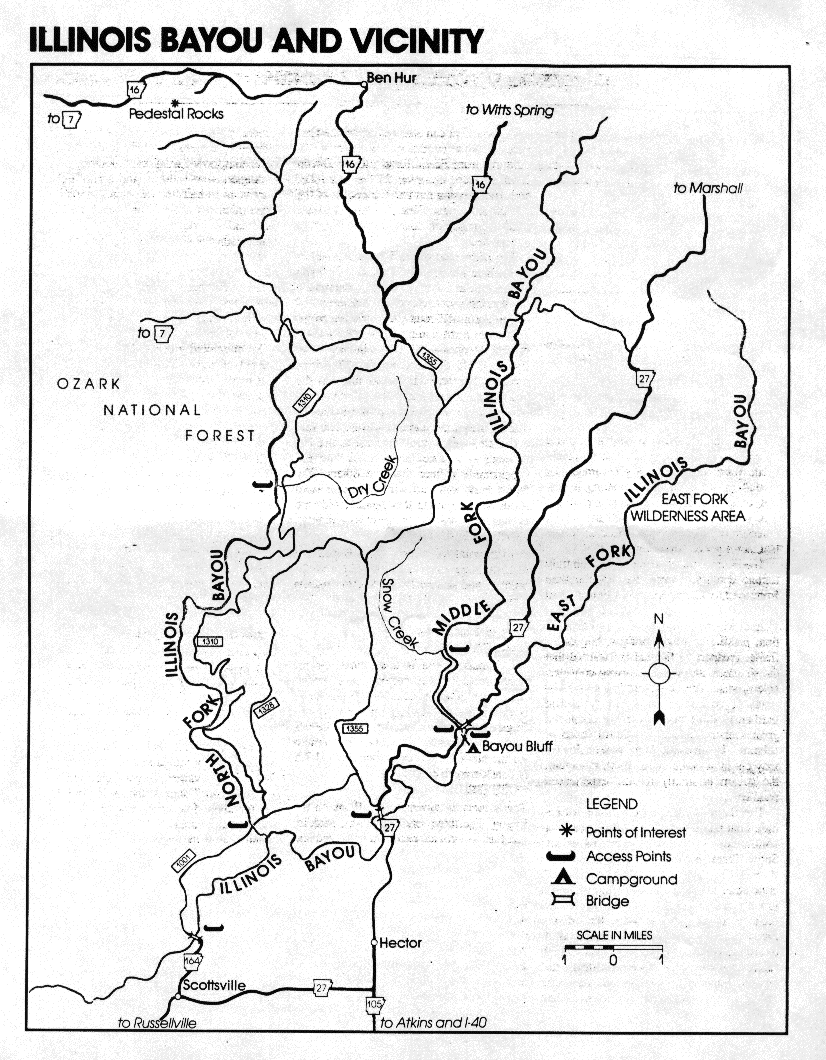Illinois Bayou

Illinois Bayou map
For most of us, the term "bayou" means one thing: a sluggish body
of water. But anybody getting on the Illinois Bayou with that thought
in mind is in for a big and wet surprise.
The Bayou, as many of its floaters know it, has its origins high up on the south slopes of the Ozarks. As the stream works its way toward Russellville and the Arkansas River, there's nothing slow and lazy about it. It may be the only bayou in the country featuring class II/III whitewater.
SECTION DESCRIBED
Entire length from backwaters of Lake Dardanelle to headwaters in the Ozarks.
CHARACTERISTICS
The Illinois Bayou really is not one stream but four: 1) the North Fork; 2) the Middle Fork; 3) the East Fork; and 4) the main stem (downstream from Bayou Bluff). Because of these divisions in what is a relatively small watershed, it takes a good amount of rainfall to get them up to floating levels. But once there, they offer some of the state's best whitewater. In fact, the Bayou is recommended for experienced paddlers. It is not a good "first time" float.
The North Fork offers a trip through truly remote country. During the 10-mile float from the Dry Creek put-in (on Forest Road 1310) to the Forest Road 1001 take-out, visitors will be well removed from civilization, passing no roads, bridges, houses, or fields. Prospective floaters are warned that the shuttle is an ordeal involving considerable driving. The float itself is a delight - class II and III rapids ( 19 feet/mile gradient), short pools, narrow channels, great scenery, and a wonderful sense of solitude. In times of high water, floaters may put in at Forest Road 1000, but again, the stream is strictly for the experienced paddler.
The Bayou's Middle Fork offers a two-mile float that is one of Arkansas's best for continuous whitewater. It begins at the Snow Creek put-in (two miles up Forest Road 1312, off Arkansas Highway 27) and concludes at Bayou Bluff Campground, just below the junction of the Middle and East Forks. Along the way, the stream drops 20 feet per mile, creating all kinds of excitement including some class 11/111 rapids. Unlike the North Fork's float, this Middle Fork section is seldom far from roads, yet it also offers a sense of remoteness.
A good float can also be had on the East Fork - when conditions are right. A 12-mile trip from Forest Road 1301 to Bayou Bluff is steep, dropping 25 feet per mile, and wild, passing through the middle of the 10,800 acre East Fork Wilderness Area. Like its companion floats, this one is not for the novice.
The main stem of the Illinois Bayou begins where the Middle and East Forks run together near Bayou Bluff and continues, for floating purposes, to the Arkansas 164 bridge north of Scottsville. This stretch includes the most commonly floated section of the Bayou - the four-mile trip from Bayou Bluff to the Arkansas 27 bridge north of Hector. Throughout this trip the paddler can expect many class II rapids, including one just upstream from the take-out that features large standing waves. The second float - from the 27 bridge to the 164 crossing - is about seven miles long and considerably calmer than the others. The North Fork joins up with the main stem about halfway along this float. Rapids are present, but most are of the class I variety.
ACCESS POINTS
Primary points of access for the Bayou and its forks are the Arkansas 164 and 27 bridges, and several Forest Road crossings (chiefly 1000, 1001, 1301, and 1312). The Highway 27 access is less than 20 miles north of Interstate 40.
SEASONS
The Illinois Bayou is a seasonal stream, floatable only after periods of extended rainfall. A good indicator of "floatability" is the Scottsville reading on the Corps of Engineers' recording (378-5150). Levels between 6.0 and 7.0 are best (6.5 minimum for the North Fork), and much beyond 7.5 is considered risky.
SCENERY
The scenery is superb for all floats on the Bayou. The three forks - North, Middle, and East - provide exposure to rugged and remote country. Rocky outcrops, steep hillsides of dense forest, and periodic glimpses of wildlife can be expected. The main stem offers overhanging trees, interesting vistas, and occasional scenes of pastoral landscapes.
FISHING
Bass are king on Illinois Bayou, and anglers will find healthy populations of three species - the largemouth, smallmouth and spotted basses. Bass fishing is generally best in spring and early summer, although some anglers prefer to fish the pot holes that form during drier months.
Anglers who want to land a real lunker may want to bait up with small sunfish or large minnows and try for one of the flathead catfish lurking in these waters. Cold-water flatheads may reach weights up to 50 pounds or more, making them the largest fish available to float stream fishermen. The best flathead fishing is at night, and the best areas to try include washouts around downed timber and deep holes in the outside bends of the stream.
Multi-colored green and longear sunfish are also abundant in Illinois Bayou. These fish readily accept worms, crickets, mini-jigs and tiny crank-baits, and while they rarely reach even a pound in weight, they can provide hours of fishing fun for kids and adults alike.
SERVICES AVAILABLE
Most any necessity (other than rental canoes) can be obtained in the nearby towns of Hector and Atkins. The nearest outfitter is located on Big Piney Creek to the west. Camping is possible at the Bayou Bluff Campground at the confluence of the Middle and East Forks. In addition, the Forest Service has other developed campgrounds - like Brock Creek and Long Pool - that are within easy driving distance.
OTHER INFORMATION
One of Arkansas's more interesting geological marvels can be observed at Pedestal Rocks, a site within the watershed of the Illinois Bayou's North Fork. In addition to seeing the large, weathered limestone columns, visitors to the area can poke around in caves and bluff shelters. Photographers will also enjoy the panoramic views of the North Fork's valley. To get there, turn east off Arkansas 7 onto Arkansas 16, and then go for about five miles toward Ben Hur. The parking area will be visible on the south side of the highway.
Another interesting area is the East Fork Wilderness. While it is accessible by canoe at times, the best way to see the wilderness is by foot. Features include upland swamps, waterfalls, and generally rugged country. The best times for visits are during fall, winter, and spring months.
Finally, floaters should bear in mind that private property does exist within the Ozark National Forest. "Posted'' land should not be entered.

ARKANSAS RIVERS & CREEKS
Big Piney Creek
Buffalo River
Caddo River
Cadron Creek
Cossatot River
Crooked Creek
Eleven Point River
Illinois Bayou
Kings River
Little Missouri River
Little Red River
Mulberry River
Ouachita River
Saline River
Spring River
Strawberry River
White River



![[CleanWeb Approved Site]](cwlogo.gif)
This page hosted by  Get your own Free Home Page
Get your own Free Home Page
© 1997, 1998 arkoutdoors




![[CleanWeb Approved Site]](cwlogo.gif)
 Get your own Free Home Page
Get your own Free Home Page
